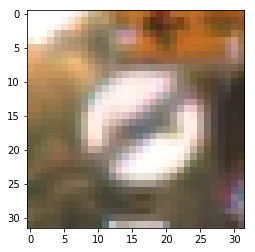--
利用深度神经网络来识别交通标志
这是 Udacity 无人驾驶工程师课程第一学期的第 2 个项目。
我们利用基于 LeNet 的神经网络来识别交通标志。
LeNet 的基本使用见于上一篇博客。
LeNet
而我的这个项目的实现代码在: github
1. 数据集
你可以用:
German Traffic Sign Dataset
也可以用:
32*32 dataset
前者是一个完整的数据集,后者已经裁剪好成为了 32*32 的大小的,而且是 pickle 文件格式,不需要额外文本文件和 image 文件读取过程。
我们可以这样读取数据集:
import pickle
training_file = './train.p'
validation_file= './valid.p'
testing_file = './test.p'
with open(training_file, mode='rb') as f:
train = pickle.load(f)
with open(validation_file, mode='rb') as f:
valid = pickle.load(f)
with open(testing_file, mode='rb') as f:
test = pickle.load(f)
X_train, y_train = train['features'], train['labels']
X_valid, y_valid = valid['features'], valid['labels']
X_test, y_test = test['features'], test['labels']
print('X_train shape = ', X_train.shape)
print('y_train shape = ', y_train.shape')
print('X_valid shape = ', X_valid.shape)
print('y_valid shape = ', y_valid.shape)
print('X_test shape = ', X_test.shape)
print('y_test shape = ', y_test.shape)
训练集是:(34799, 32, 32, 3) ,(34799,)
验证集是:(4410, 32, 32, 3),(4410,)
测试集是:(12630, 32, 32, 3),(12630,)
2. 数据快速浏览
import matplotlib.pyplot as plt i = 234 plt.imshow(X_train[i]) print(y_train[i]) plt.show() plt.imshow(X_train[i]) print(y_train[i]) plt.show() print(np.unique(y_train)) print(np.unique(y_valid)) print(np.unique(y_test))我们可以看到样本基本上长这个样子:



另外有一个描述了 从label 到实际标签对应关系的索引从文件 signnames.csv
ClassId SignName 0 Speed limit (20km/h) 1 Speed limit (30km/h) 2 Speed limit (50km/h) 3 Speed limit (60km/h) 4 Speed limit (70km/h) 5 Speed limit (80km/h) 6 End of speed limit (80km/h) 7 Speed limit (100km/h) 8 Speed limit (120km/h) 9 No passing 10 No passing for vehicles over 3.5 metric tons 11 Right-of-way at the next intersection 12 Priority road 13 Yield 14 Stop 15 No vehicles 16 Vehicles over 3.5 metric tons prohibited 17 No entry 18 General caution 19 Dangerous curve to the left 20 Dangerous curve to the right 21 Double curve 22 Bumpy road 23 Slippery road 24 Road narrows on the right 25 Road work 26 Traffic signals 27 Pedestrians 28 Children crossing 29 Bicycles crossing 30 Beware of ice/snow 31 Wild animals crossing 32 End of all speed and passing limits 33 Turn right ahead 34 Turn left ahead 35 Ahead only 36 Go straight or right 37 Go straight or left 38 Keep right 39 Keep left 40 Roundabout mandatory 41 End of no passing 42 End of no passing by vehicles over 3.5 metric tons
3. model 可以参考 Yann LeKun 的这篇文章 作为一个 baseline 的accuracy 可以达到 98.97 %。
而人眼识别的正确率在 98.81 %。 现在我们来搭建自己的神经网络:
import numpy as np X_train_input = np.mean(X_train, axis = 3)/255 X_train_input = np.expand_dims(X_train_input, axis = 4) X_valid_input = np.mean(X_valid, axis = 3)/255 X_valid_input = np.expand_dims(X_valid_input, axis = 4) X_test_input = np.mean(X_test, axis = 3) / 255 X_test_input = np.expand_dims(X_test_input, axis = 4)
先对数据进行归一化,使得 从 RGB 转化为灰度图,灰度图的值大小为 RGB 的平均值,再除以 255 归一到 0.0 ~ 1.0
同时保持数据维度为 4, [sample_cnt, width, height, layer]
搭建神经网络
import tensorflow as tf
def buildNet(x, keep_rate):
mu = 0
sigma = 0.01
conv1_W = tf.Variable(tf.truncated_normal(shape=(3, 3, 1, 16), mean = mu, stddev = sigma))
conv1_b = tf.Variable(tf.zeros(16))
conv1 = tf.nn.conv2d(x, conv1_W, strides=[1, 1, 1, 1], padding='VALID') + conv1_b
conv1 = tf.nn.relu(conv1)
conv2_W = tf.Variable(tf.truncated_normal(shape=(3, 3, 16, 32), mean = mu, stddev = sigma))
conv2_b = tf.Variable(tf.zeros(32))
conv2 = tf.nn.conv2d(conv1, conv2_W, strides=[1, 1, 1, 1], padding='VALID') + conv2_b
conv2 = tf.nn.relu(conv2)
conv2 = tf.nn.max_pool(conv2, ksize=[1, 2, 2, 1], strides=[1, 2, 2, 1], padding='VALID')
conv3_W = tf.Variable(tf.truncated_normal(shape=(3, 3, 32, 64), mean = mu, stddev = sigma))
conv3_b = tf.Variable(tf.zeros(64))
conv3 = tf.nn.conv2d(conv2, conv3_W, strides=[1, 1, 1, 1], padding='VALID') + conv3_b
conv3 = tf.nn.relu(conv3)
conv3 = tf.nn.max_pool(conv3, ksize=[1, 2, 2, 1], strides=[1, 2, 2, 1], padding='VALID')
conv4_W = tf.Variable(tf.truncated_normal(shape=(3, 3, 64, 64), mean = mu, stddev = sigma))
conv4_b = tf.Variable(tf.zeros(64))
conv4 = tf.nn.conv2d(conv3, conv4_W, strides=[1, 1, 1, 1], padding='VALID') + conv4_b
conv4 = tf.nn.relu(conv4)
conv4 = tf.nn.max_pool(conv4, ksize=[1, 2, 2, 1], strides=[1, 2, 2, 1], padding='VALID')
fc0 = tf.contrib.layers.flatten(conv4)
fc1_W = tf.Variable(tf.truncated_normal(shape=(256, 128), mean = mu, stddev = sigma))
fc1_b = tf.Variable(tf.zeros(128))
fc1 = tf.matmul(fc0, fc1_W) + fc1_b
fc1 = tf.nn.relu(fc1)
fc1 = tf.nn.dropout(fc1, keep_rate)
fc2_W = tf.Variable(tf.truncated_normal(shape=(128, 64), mean = mu, stddev = sigma))
fc2_b = tf.Variable(tf.zeros(64))
fc2 = tf.matmul(fc1, fc2_W) + fc2_b
fc2 = tf.nn.relu(fc2)
fc2 = tf.nn.dropout(fc2, keep_rate)
fc3_W = tf.Variable(tf.truncated_normal(shape=(64, n_classes), mean = mu, stddev = sigma))
fc3_b = tf.Variable(tf.zeros(n_classes))
logits = tf.matmul(fc2, fc3_W) + fc3_b
return logits
x = tf.placeholder(dtype = tf.float32, shape = (None, 32, 32, 1))
y = tf.placeholder(dtype = tf.int32, shape = (None))
one_hot_y = tf.one_hot(y, n_classes)
keep_prob = tf.placeholder(dtype = tf.float32)
这里和LeNet 不同的是,我们的最后的 flatten 输出 n_classes 是 43 而不是 MNIST 数据集里面的 10
接下来是整个训练、预测、测试函数
from sklearn.utils import shuffle
batch_size = 128
learning_rate = 0.001
logits = buildNet(x, keep_prob)
with tf.name_scope('summaries'):
cross_entropy_loss = tf.reduce_mean(tf.nn.softmax_cross_entropy_with_logits(labels = one_hot_y, logits=logits))
optimizer = tf.train.AdamOptimizer(learning_rate = learning_rate)
training_operation = optimizer.minimize(cross_entropy_loss)
correct_prediction = tf.equal(tf.argmax(logits, 1), tf.argmax(one_hot_y, 1))
accuracy_operation = tf.reduce_mean(tf.cast(correct_prediction, tf.float32))
# tf.summary.scalar("loss", cross_entropy_loss)
# tf.summary.scalar("accuracy", accuracy_operation)
saver = tf.train.Saver()
merged_summary_op = tf.summary.merge_all()
def evaluate(sess, X_data, y_data):
num_examples = len(X_data)
total_accuracy = 0.0
for offset in range(0, num_examples, batch_size):
batch_x, batch_y = X_data[offset:offset + batch_size], y_data[offset:offset+batch_size]
# no use of dropout if evaluation the model
feed = {x: batch_x, y: batch_y, keep_prob: 1.0}
accuracy = sess.run(accuracy_operation, feed_dict=feed)
total_accuracy += (accuracy * len(batch_x))
return total_accuracy / num_examples
def train(X_data, y_data, epoch = 2, learning_rate = 0.001):
assert len(X_data) == len(y_data)
with tf.Session() as sess:
sess.run(tf.global_variables_initializer())
train_writer = tf.summary.FileWriter(logs_path+ '/train/', graph=tf.get_default_graph())
print("Training begin...")
print()
num_examples = len(X_data)
for i in range(epoch):
print('epoch ' + str(i+1) + '/'+ str(epoch) +' begin...')
X_data, y_data = shuffle(X_data, y_data)
epoch_train_accuracy = 0.0
for offset in range(0, num_examples, batch_size):
end = offset + batch_size
batch_x, batch_y = X_data[offset:end], y_data[offset:end]
feed = { x: batch_x, y: batch_y, keep_prob: 0.75 }
_, batch_train_accuracy = sess.run(
[training_operation, accuracy_operation], feed_dict= feed)
epoch_train_accuracy += batch_train_accuracy * len(batch_x)
epoch_train_accuracy /= num_examples
print('train accuracy ={:.3f}'.format(epoch_train_accuracy))
validation_accuracy = evaluate(sess, X_valid_input, y_valid)
print("Validation Accuracy = {:.3f}".format(validation_accuracy))
print()
saver.save(sess, './lenet')
train_writer.close()
print("Model saved")
def test(X_data, y_data):
assert len(X_data) == len(y_data)
num_examples = len(X_data)
with tf.Session() as sess:
saver.restore(sess, tf.train.latest_checkpoint('.'))
print('restore previously saved model under ./lenet')
print("testing begin...")
print()
test_accuracy = evaluate(sess, X_data, y_data)
print("testing accuracy = {:.3f}".format(test_accuracy))
print()
return test_accuracy
这里我们利用 Saver 来保存模型的状态。
4. 运行这个模型
train(X_train_input, y_train, epoch = 30)
test_accuracy = test(X_test_input, y_test)
print("Test Accuracy = {:.3f}".format(test_accuracy))
5. 利用新的数据来进行测试
import cv2
import os
import numpy as np
myimgs_gray = []
myimgs_color = []
dirname = 'mysamples'
for filename in os.listdir(dirname):
if '.jpg' in filename:
myimg = cv2.imread(os.path.join(dirname, filename))
myimg = cv2.resize(myimg, (32, 32))
myimgs_color.append(myimg)
myimg = cv2.cvtColor(myimg, cv2.COLOR_BGR2GRAY)
myimgs_gray.append(myimg)
print('total ', len(myimgs_gray), 'images from web search loaded')
myimgs_input =np.expand_dims(myimgs_gray, axis = 3)
我们再利用已经训练好的模型,来预测我们的样本
argmax_item = tf.argmax(logits, 1),
def predict(X_data):
num_examples = len(X_data)
print('totally '+str(num_examples) + ' to be predicted')
with tf.Session() as sess:
saver.restore(sess, tf.train.latest_checkpoint('.'))
print('restore previously saved model under ./lenet')
result = sess.run(argmax_item, feed_dict = {x: X_data, keep_prob : 1.0})
print(result)
return result
predicts_y = predict(myimgs_input)